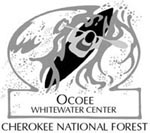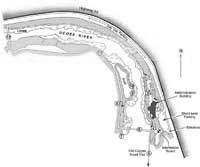


|
In 1994, the Forest Service began building a world class slalom canoe/kayak race course in order to expand paddling opportunities on the Ocoee River and promote economic development in the Ocoee Region. The grand debut of the race course was at the 1996 Olympic games. Now the Ocoee Whitewater Center (OWC) is not only one of the world's best whitewater race facilities, but it is also a center for nature-based recreation in southeast Tennessee. Numerous geologic aspects were considered during the planning, design, and construction of the whitewater course. But let's start at the very beginning. |
|
Other rocks were brought to the OWC in order to build the levees, highway, embankments, and the Administration building. The levees and embankments were made of over 60,000 tons of rock -- some desk-sized and weighing about 7 tons. The new levees pinched the river to almost one-half of its width in order to create the needed water flows for whitewater racing. Before construction, the river was cleaned to remove woody debris, loose rock, and sand. Limestone core rock was placed in the clean and dry river bed. Then sandstone boulders were set individually on top of these to mimic the natural arrangement of rocks in a river. The rocks were grouted to the bedrock, and to each other, to ensure stability. The limestone buffers acidity and improves water quality along this section of the Ocoee. The sandstone boulders maintain the natural character of the river and were gathered from a mountainside boulder field on the Cherokee National Forest. At the Administration Building, sandstone was used for the terraces and building veneer. Marble was placed in bands across the terraces to resemble the quartz veins in the metagraywacke outcrops of the Ocoee gorge.
Also, in order to create world class rapids, fourteen artificial or "faux" rock features were built in the river. The same company that created the Ocoee faux rock built rock for the Tennessee Aquarium in Chattanooga. |

|

|
To take the geology tour, click on the thumbnail map. |
Metagraywacke*
Late Proterozoic -- 750 million years old. A metamorphosed medium- to coarse-grained, poorly-sorted gray sandstone. The metagray-wacke beds may contain pyrite and are inter-bedded with black argillite.
Limestone
Early Ordovician -- 500 million years old. Brought in for construction from a Tennessee valley quarry. A sedimentary rock consisting mostly of calcium carbonate. The color is light gray.
Sandstone
A sedimentary rock composed mostly of quartz sand.
Boulders
Lower Ordovician -- 500 million years old.
Building stone
Pennsylvanian -- 300 million years old. The building stone was brought from a quarry near Crossville, Tennessee. The color is tan with pink and white variations, often with pyritic orange spots.
Marble
Early Paleozoic -- 450 million years old. A metamorphosed limestone. The white marble in terraces is similar to marbles quarried near Tate, Georgia.
*NOTE that the iron stain comes from weathered pyrite and colors both of these rocks a rusty orange in the river channel.
The United States Department of Agriculture (USDA) and Department of Interior (DOI) prohibit discrimination in their programs on the basis of race, color, national origin, sex, religion, age, disability, political beliefs, and marital or familial status. (Not all prohibited bases apply to all programs.)Persons with disabilities who require alternative means of communication of program information (braille, large print, audiotape, etc.) should contact the USDA TARGET CENTER: 1-202-720-2600 (Voice/TTD).
To file a complaint, write the Secretary of Agriculture, U.S. Depart-ment of Agriculture, Washington, DC 20250, or call:
1-800-245-6340 (Voice) or 1-202-720-1127 (TTD).USDA and DOI are equal employment opportunity employers.
|
Forest Service |

|
Southern Region |
||
|
U.S. Department of Agriculture
Brochure prepared in cooperation with the |
||||
VIEW a list of other USGS General Interest Publications
This page is https://pubs.usgs.gov/gip/ocoee/
Maintained by Publications Services
Last updated 8-17-99